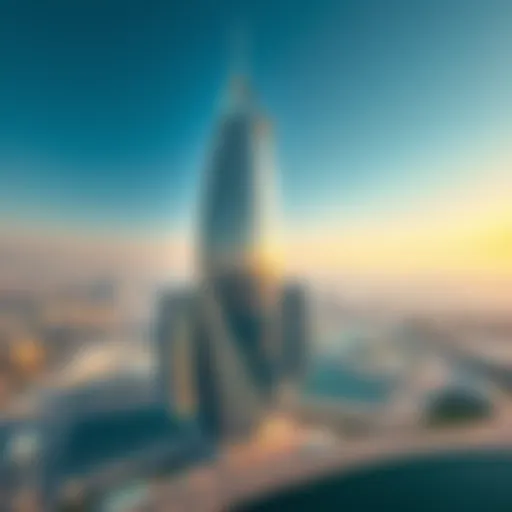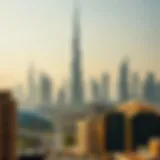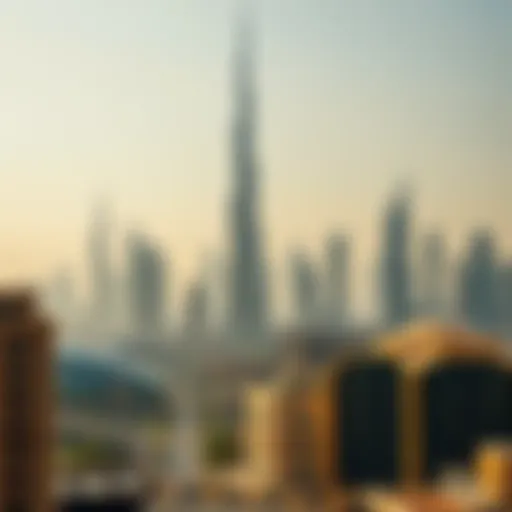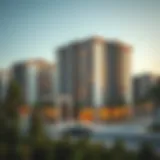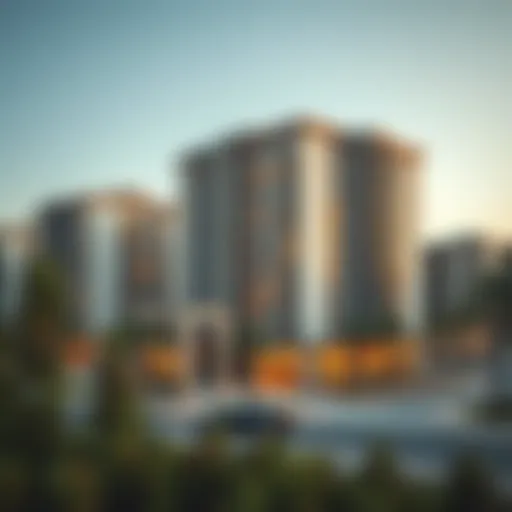Evaluating the Financial Impact of Burj Khalifa


Intro
The Burj Khalifa stands as a towering testament to modern ingenuity and ambition. Located in the heart of Dubai, it isn't just a skyscraper; it's a symbol of economic power and architectural prowess. As the tallest man-made structure in the world, its sheer height and striking design capture the imagination, drawing millions of visitors each year. However, beyond its breathtaking aesthetics lies a complex web of financial considerations. This article aims to peel back the layers of this iconic landmark, offering insight into its financial value—from the exorbitant costs involved in its construction to its current standing in the ever-evolving Dubai real estate market.
Market Trends
Current Real Estate Trends in Dubai
In recent years, Dubai has seen its real estate market undergo significant fluctuations. Post-pandemic revival efforts have sparked a renewed interest in property investments, with an emphasis on luxury developments, including those in close proximity to the Burj Khalifa. According to recent data, property prices in areas like Downtown Dubai, where the Burj Khalifa is located, have shown a steady incline. Factors such as foreign investment, urbanization, and infrastructural advancements contribute to this trend.
- Increased Demand: The allure of luxury living in a world-class city attracts high-net-worth individuals.
- Tourism Growth: With international travel slowly recovering, Dubai's tourism sector is bouncing back, supporting property values.
- Global Investment: Investors from countries like India, the UK, and China are increasingly eyeing Dubai real estate as a safe investment haven.
These elements combine to present a favorable climate for property values, especially for premium locations.
Future Forecasts for the Dubai Property Market
Looking ahead, forecasts suggest a continued upward trajectory in Dubai's property market. Industry experts are optimistic, projecting favorable conditions for investments around the Burj Khalifa and similar icons. Factors influencing future growth include:
- Expo 2020's Impact: Although delayed, the effects of this world's fair are expected to boost tourism, creating a ripple effect.
- Sustainability Trends: As eco-friendly buildings become more in demand, developers focused on sustainable design may find lucrative opportunities.
- Regulatory Support: The government's evolving regulations promote foreign ownership and streamline processes, encouraging investment.
By analyzing these trends, potential investors can make informed decisions, aligning their strategies with market dynamics.
Property Types
Residential Properties: Overview and Insights
Residential properties surrounding the Burj Khalifa offer a blend of luxury and exclusivity. Towers like The Address and Burj Vista provide stunning views and high-end amenities. The demand for high-end condos and apartments continues to rise, driven by both local homeowners and international investors.
- Prime Locations: Properties with vistas of the Burj Khalifa command premium prices, often fetching above market rates.
- Amenities Appeal: Features such as concierge services, pools, and gyms appeal to affluent buyers.
- Investment Potential: Properties in this vicinity are not just homes; they represent long-term investment assets, often appreciating over time.
Commercial Properties: Opportunities and Challenges
In the commercial realm, the proximity to the Burj Khalifa makes properties in this area sought after. Office spaces, retail ventures, and leisure facilities all thrive under its towering presence. However, there are notable challenges.
- High Operating Costs: The expense of maintaining premium commercial spaces can be significant, requiring careful financial planning.
- Competitive Market: With increasing developments, standing out becomes crucial—businesses must offer unique value propositions.
- Market Saturation Risks: Although the demand is strong, oversupply could impact rental rates and occupancy levels in the future.
Understanding these dynamics gives businesses and investors a clearer picture of the commercial landscape in Dubai.
The economic impact of the Burj Khalifa extends beyond real estate—it's a cultural icon that shapes the very identity of Dubai itself.
As this analysis unfolds, distinct layers of the Burj Khalifa’s financial value come to light, emphasizing not only its architectural splendor but its vital role in shaping the Dubai economy.
Intro to Burj Khalifa
The Burj Khalifa, standing tall as a beacon of architectural and economic prowess, has captivated global attention since its completion in 2010. This towering figure isn't merely another skyscraper; it represents a significant milestone in engineering and design as well as a vital piece of Dubai’s urban landscape. Exploring its financial value involves an understanding of its intricate history, architectural marvels, and its role in shaping the local economy.
The impact of Burj Khalifa extends far beyond its glimmering facade. This monument has become a symbol of modernity and ambition, driving tourism and investment to unprecedented heights. For investors, homebuyers, agents, analysts, and developers, an assessment of its financial worth offers vital insights into both historic and emerging trends in real estate.
Historical Background
The story of Burj Khalifa began in the early 2000s when the demand for luxurious urban living escalated in Dubai. As part of a larger urban development project, known as Downtown Dubai, the decision to construct this skyscraper was initially fueled by ambitions of creating one of the world’s most extravagant cities, showcasing rapid growth and opulence. Construction kicked off in 2004, with significant milestones achieved through a collaborative effort among famous architects, engineers, and construction firms.
Key Historical Points:
- Inauguration in 2010 marked a new epoch for Dubai.
- The building was developed by Emaar Properties, an iconic name in Middle Eastern real estate.
- The design was conceptualized by the renowned architecture firm Skidmore, Owings & Merrill, bringing forth an innovative vision.
Architectural Design and Features
From the outset, the Burj Khalifa has been a testament to creativity and ingenuity. Rising to a staggering height of 828 meters (2,717 feet), it’s not just the tallest building in the world; it’s an embodiment of cutting-edge design principles. Unique features, such as the Y-shaped floor plan, promote structural stability while providing stunning views throughout. The facade, clad in reflective glass, serves both esthetic and environmental purposes by reducing energy consumption.


Notable Architectural Features:
- Design Inspiration: The tower draws architectural inspiration from the Hymenocallis flower, integrating not just form but also function.
- Sky Lobbies: Positioned at various heights, these lobbies are designed for flexibility and accessibility, making vertical transportation efficient.
- Sustainable Elements: Elements like the high-performance double-glazed facade attest to a commitment to sustainability without sacrificing luxury.
Construction Overview
The construction of the Burj Khalifa was not merely an undertaking of bricks and mortar; it was a monumental endeavor that encapsulated bold engineering and innovative architectural design. Understanding the construction overview provides a necessary lens through which to assess its immense financial value. Key components of this section highlight the timeline and pivotal milestones that underline its significance, as well as the materials and technologies responsible for shaping this iconic structure.
Timeline and Key Milestones
The journey of the Burj Khalifa began in 2004, marked by the solemnity of groundbreaking activities that set the stage for innovation. Each tick of the clock brought new achievements and challenges, as the project unfolded in phases.
- 2004: Groundbreaking ceremony, initiated by the then Ruler of Dubai, Sheikh Mohammed bin Rashid Al Maktoum.
- 2007: The building reached its half-height milestone, boasting structural accomplishments that turned many heads around the globe.
- 2010: The official inauguration was held on January 4, a day that would echo through history, solidifying Dubai's status on the world stage.
This timeline is not just a series of dates; it reflects the resolve and vision of Dubai’s leaders and the countless laborers who toiled day and night against the scorching desert sun to bring this dream to life. Significant hurdles, like the project’s ambitious height, were conquered with innovation, an endeavor reflecting the determination of a city resolute in its aspirations.
Materials and Technologies Used
To build a structure of Burj Khalifa's stature, the choice of materials and technologies was driven by a blend of necessity and ambition. The foundation alone demanded a staggering 45,000 cubic meters of concrete, which plays a pivotal role in supporting a tower that reaches the sky.
- Concrete: A mixture of advanced cement and aggregate designed to withstand not just the weight above but also the shifting desert sands below.
- Steel Rebar: This reinforces the concrete, contributing to the structural integrity of the tower, which stands as a bastion of modern engineering.
- Cranes and Lift Technologies: The construction utilized custom-built cranes, crucial for transporting the enormous materials necessary for the heights achieved.
In addition, innovative glass and cladding solutions were designed for energy efficiency, helping maintain internal temperatures against the brutal climate of Dubai. The use of reflective glass not only enhances the aesthetic appeal but also reduces solar heat reception, which speaks volumes about contemporary design practices prioritizing sustainability.
"The Burj Khalifa is a testament to what dreams can achieve when they are intertwined with determination and forward-thinking technologies."
In an arena where many buildings have come and gone, the Burj Khalifa emerges as a paragon of engineering excellence and architectural beauty, pivotal to understanding its financial evaluation in the broader context of Dubai’s monumental achievements. By dissecting the timeline and innovative practices that birthed this skyscraper, investors and stakeholders can better appreciate its enduring value in the ever-evolving real estate landscape.
Initial Cost and Funding
Understanding the initial cost and funding of the Burj Khalifa is more than just a number; it’s the cornerstone of its financial narrative. The construction of such a monumental structure demands a multi-faceted approach to funding, influenced by both its architectural grandeur and the ambitious vision behind Dubai's transformation into a global hub. The financial implications of this towering edifice extend beyond brick and mortar; they resonate deeply through the economic landscape of Dubai and its burgeoning real estate market.
Breakdown of Construction Costs
When dissecting the expenses incurred in the building of the Burj Khalifa, it’s crucial to look at the figures that tell the tale of immense investment. The construction costs were estimated at approximately $1.5 billion, a staggering amount that reflects not only the building’s height but the level of engineering mastery involved. One could say each dollar spent was a building block in a journey towards architectural excellence.
- Site Preparation: Before the first stone was laid, a significant sum went into preparing the site. This included soil stabilization methods essential for a structure of this magnitude.
- Material Costs: Nearly 330,000 cubic meters of concrete and 103,000 square meters of glass were employed, contributing heavily to the costs. The choice of materials was not arbitrary; it aligned with the desire for sustainability and structural soundness.
- Labor and Expertise: Employing over 12,000 workers at peak construction times, human resources and expert labor made up a considerable chunk of the expenditure. The intricate designs necessitated a team of international contractors and artisans, each bringing unique skills to the table.
- Technological Innovations: The implementation of cutting-edge technologies, including sophisticated elevators and energy systems, not only increased upfront costs but also positioned Burj Khalifa as a pioneer in architectural technology.
By breaking down these costs, we see the fiscal commitment to not only build a building but to create a landmark that would redefine skylines across the globe.
Financing Options and Sources
To finance a project as grand as the Burj Khalifa, a variety of strategies and sources were crucial.
- Public-Private Partnerships: The initial funding surged from joint efforts between government entities and private investors. Such collaborations helped spread financial risk while fueling the aspirations associated with Dubai’s real estate boom.
- Sukuk Bonds: The project took advantage of Islamic finance through Sukuk bonds. This method allowed the construction firm to raise funds without directly affecting ownership stakes.
- Equity Financing: Major stakeholders, including Emaar Properties, actively engaged in equity investments, thus ensuring a solid foundation for the project's initial funding. The allure of returns from property development in the downtown area was inviting for investors considering long-term gains.
- Bank Loans: Traditional financing routes, including loans from banks and financial institutions, supplemented these other options effectively, providing necessary cash flow during crucial construction phases.
These financial avenues illustrate how various elements came together to make the Burj Khalifa not just a product of design and engineering but a testament to strategic financial planning.
Current Market Evaluation
Understanding the current market evaluation of the Burj Khalifa is crucial for anyone involved in real estate investment, urban development, or simply those taking an interest in iconic structures. This evaluation sheds light on the financial worth of the building, taking into account myriad factors such as location, demand, and market dynamics. It paints a picture of how well the Burj Khalifa stands not just as a symbol of architectural bravado, but also as a substantial economic asset.
The significance here revolves around the interplay between perception and reality. The perception of the Burj Khalifa, as a monument in a bustling urban landscape, can often surpass its actual value. Here, we look at two key areas that underscore this evaluation: real estate appraisal methods and market comparisons.
Real Estate Appraisal Methods
Appraising the Burj Khalifa is no small feat. The methods employed for such an evaluation often blend traditional techniques with innovative strategies. Investors and analysts deploy several approaches that include:
- Income Approach: This focuses on the potential revenue generated by the residential and commercial spaces within the skyscraper. Analyzing rental income against operating expenses provides a solid foundation for estimating market value.
- Sales Comparison Approach: In this method, appraisers look at similar high-value properties recently sold in Dubai. This contextualizes the Burj Khalifa’s worth in relation to comparable assets, allowing for more informed estimations.
- Cost Approach: While understanding the original construction cost is essential, adjusting for depreciation and current condition gives a fresh perspective on value. Given its monumental status, this approach must also consider the expenses for ongoing maintenance and updates.


Utilizing these methods provides a well-rounded view of the financial landscape surrounding the Burj Khalifa. Each technique presents a unique viewpoint that contributes to the overarching assessment of this extraordinary building’s worth.
Market Comparisons
When evaluating the Burj Khalifa, it’s imperative to consider it in relation to other skyscrapers and landmark properties. Market comparisons help us understand its position in the highly competitive arena of real estate.
Several key elements enhance this comparison:
- Location Impact: The Burj is strategically placed in the heart of Dubai, surrounded by attractions like The Dubai Mall and the Dubai Fountain. This prime location significantly boosts its market valuation compared to structures in less favorable areas.
- Amenities and Features: The skyscraper is not just a tall building; it offers luxurious amenities that include fine dining options, observation decks, and premium residences. Evaluating how these amenities stand against those in rival high-rise buildings contributes to overall market assessments.
- Cultural Relevance: The Burj Khalifa isn’t only a property; it symbolizes Dubai's ambition and cosmopolitan flair. Its reputation attracts both tourists and potential investors, adding a layer of intrinsic value that pure financial metrics may overlook.
By exploring these aspects, investors can understand how the Burj Khalifa thrives in the bustling real estate market of Dubai.
"The worth of a landmark like Burj Khalifa is never strictly a number; it’s an amalgamation of culture, tourism, and real economic impact."
With such an intricate tapestry of factors influencing its financial assessment, the Burj Khalifa stands as more than merely a tall structure—it's an integral part of Dubai's economic and cultural identity. The insights gained from these evaluations not only serve investors but also articulate the skyscraper's continuing significance in the global context.
Economic Impact on Dubai
The Burj Khalifa stands not just as an architectural marvel but as a powerful catalyst for economic growth in Dubai. Its towering presence has redefined the skyline and served as a magnet for both tourists and investors. The implications of its existence stretch far beyond mere aesthetics; they encompass socio-economic factors that have contributed significantly to Dubai's status as a global hub.
One of the essential aspects of this topic is the correlation between the Burj Khalifa and tourist influx. When folks think of Dubai, the image of this needle-like structure pops up. It’s no surprise that tourism has burgeoned since its completion, with millions descending upon this glittering oasis in the desert each year. The Burj Khalifa attracts droves of visitors not just to its viewing deck but also to the nearby attractions, hotels, and restaurants, feeding a cycle of economic activity.
Tourism and Visitor Statistics
A closer look at the numbers reveals the Burj Khalifa's staggering impact on tourism. The observation deck alone draws about 1.5 million visitors annually, with people traveling from across the globe eager to catch a glimpse of the sprawling city from dizzying heights. The sheer volume of tourists contributes significantly to local businesses.
- Hotels and Hospitality: The Burj Khalifa’s proximity to luxury hotels like Armani Hotel Dubai and Address Downtown ensures that tourists have a range of accommodations right at their fingertips.
- Retail and Dining: The surrounding area, including The Dubai Mall, becomes a hive of activity, with restaurants and luxury shops enjoying a steady flow of customers.
- Cultural Events: Major events and festivals revolving around the Burj Khalifa, like the New Year’s Eve fireworks show, draw tens of thousands of spectators, further amplifying visitors' spending.
Much of this economic activity translates into job creation, both directly and indirectly. From hospitality staff to retail workers and security personnel, the Burj Khalifa supports thousands of jobs, making a substantial contribution to Dubai’s economy.
Investment and Business Opportunities
The economic value of the Burj Khalifa extends into the realm of investment as well. Real estate developers see this iconic structure as more than just a landmark; it embodies a lucrative opportunity. Properties nearby often command premium prices due to their enviable location, fueled by the Burj Khalifa’s status as a symbol of luxury and aspiration.
Investors looking to plant roots in Dubai are increasingly drawn by the commercial prospects:
- Office Spaces: The presence of multinational companies setting up base in towers adjacent to the Burj Khalifa drives demand for office space, further boosting the local economy.
- Retail Development: With the success of The Dubai Mall, new retail projects spring up that capitalize on the heavy foot traffic, ensuring a steady flow of capital into the marketplace.
- Cultural and Entertainment Venues: The ongoing interest in Dubai’s cultural landscape brings investment into art galleries and exhibition centers, enhancing the city’s appeal as a cultural destination.
Another layer of consideration lies in foreign investment attracted by the prestige of the Burj Khalifa. It serves as a beacon not just for tourists but for businesses looking to capitalize on Dubai’s strategic location—all of which collectively fortify the emirate's economy.
"The Burj Khalifa is not just a building; it’s an emblem of opportunity, growth, and prosperity for the city of Dubai."
Burj Khalifa as a Landmark
The Burj Khalifa is not just a building; it stands as a symbol of ambition, innovation, and a certain je ne sais quoi that Dubai encapsulates. As the tallest structure globally, measuring 828 meters, its piercing height is both a testament to architectural prowess and a beacon for those who seek inspiration from the unexpected. For investors, homebuyers, and industry professionals, this landmark represents more than just real estate; it illustrates the dynamic economic landscape of Dubai.
Cultural Significance
Culturally, the Burj Khalifa can be seen as a touchstone for the United Arab Emirates' rapid transformation from a modest trading post to a glittering metropolis. It embodies the spirit of progress and ambition that defines Dubai. When one walks around the base of this skyscraper, it’s easy to spot tourists from different backgrounds, all united by a shared fascination with how a desert city can manifest such extraordinary dreams.
There’s also a richness in its design narrative. The structure incorporates traditional Islamic architectural elements, such as the Yasmin flower, which symbolize beauty and tranquility. Events held at the Khalifa, such as the annual New Year’s Eve fireworks and light show, have become cultural phenomena, showcasing the UAE's cultural strength on a global stage.
"The Burj Khalifa is a cultural icon that attracts millions, making it a cornerstone of Dubai's identity and economy."
From an economic perspective, it fuels tourism and hospitality sectors, contributing a significant percentage of revenue that supports local businesses, from hotels to restaurants. Thus, its cultural significance stretches beyond the aesthetic — it’s also about the stories it creates and the opportunities it fosters.
Role in Branding Dubai
Branding is an art, and in this regard, Burj Khalifa serves as a masterstroke for Dubai. The Burj is a compelling representation of the Dubai brand, promoting an image of luxury and innovation that thrives beyond borders. It’s often said, "If you build it, they will come," and the Burj Khalifa has certainly lured numerous tourists and potential investors to explore the city.


Burj Khalifa connects Dubai's portfolio of projects like the Dubai Mall and the Dubai Fountain, creating a coherent narrative that asserts the city’s place on the world map. Every time the building graces a magazine cover or a news segment, it strengthens Dubai’s identity as a global hub for tourism and business.
Investors should note that this branding extends into commercial ventures. The prestigious address of Burj Khalifa elevates the status of any business, making it an attractive spot for brands looking to position themselves as industry leaders. The allure combined with strategic marketing makes it an exceptional asset.
In summary, the Burj Khalifa is no mere skyscraper. It embodies a rich tapestry of cultural significance and forms a crucial part of Dubai’s branding machine, further solidifying its economic importance on a global scale. Understanding this duality can significantly illuminate potential investment opportunities.
Investment Potential
Understanding the investment potential of the Burj Khalifa is crucial as it combines not only the architectural marvel but also a significant financial entity within the Dubai skyline. This towering structure attracts numerous stakeholders, from real estate investors to tourists seeking unique experiences. An exploration of this potential reveals layers of opportunity, risk, and strategic considerations for those interested in capitalizing on its presence.
Residential vs Commercial Value
The Burj Khalifa is not just a residential marvel; it also holds substantial commercial value. The distinction between these two facets is essential for potential investors to grasp.
- Residential Value: Luxury apartments within the Burj Khalifa fetch top market rates because of their unique positioning. Living higher up in the world's tallest building offers breathtaking views, a privileged lifestyle, and exclusivity. Potential buyers are often drawn to the idea that ownership here can be considered a status symbol, thereby driving up demand and prices.
- Commercial Value: The commercial spaces housed within Burj Khalifa cater to high-end businesses, including corporate offices and retail outlets. This commercial real estate benefits from high foot traffic from both tourists and residents, providing an attractive environment for businesses aiming to establish a prominent presence in Dubai. Consequently, the rents commanded by these spaces typically surpass average market values in other districts, making it an appealing prospect for investors.
Choosing between residential and commercial investment opportunities in Burj Khalifa depends largely on the investor's goals and market strategy. Investors must consider:
- Current trends in the Dubai real estate market.
- The potential for long-term appreciation versus short-term gains.
- How external factors, such as tourism fluctuations or economic shifts, can impact real estate performance.
Predicted Future Value Trajectories
When it comes to predicting the future value trajectories of property, certain dynamics come into play. For Burj Khalifa, several elements will likely shape its financial future:
- Global Economic Conditions: The resilience of Dubai’s economy has been crucial. Continuous growth, coupled with an influx of expatriates seeking vibrant living spaces, suggests sustained demand.
- Tourism Trends: As a leading tourist attraction, the Burj Khalifa’s appeal plays a significant role in its valuation. Increased tourist numbers could enhance retail and commercial opportunities, driving property values up.
- Urban Development Projects: Upcoming infrastructure and luxury developments within Dubai could influence the real estate market positively, enhancing the Burj Khalifa's value. Enhancement of public transport and additional amenities can raise the desirability of living and working near the area.
Given these factors, modeling the financial future of Burj Khalifa remains complex yet intriguing. Investors will need to stay informed about market changes, regulatory adjustments, and geographical factors influencing real estate landscapes.
Investing in such iconic structures blends allure with careful financial foresight. Ultimately, informed decision-making will be key to maximizing returns from properties located in and around the Burj Khalifa.
As the commercial and residential value of Burj Khalifa becomes further understood, stakeholders should maintain a finger on the pulse of evolving market conditions to identify opportunities for growth and stability.
Challenges and Risks
Understanding the challenges and risks associated with Burj Khalifa's financial value is crucial for anyone considering investment or involvement in Dubai's fast-paced real estate market. While the building dazzles with its height and grandeur, numerous underlying factors may influence its economic viability. Assessing these will offer a more accurate picture of its long-term value and viability.
Maintenance and Operational Costs
Like any other skyscraper, Burj Khalifa comes with a hefty price tag for maintenance and operations. This includes everything from routine cleaning to the more intricate tasks of preserving the structural integrity of the glass facade. The following aspects are essential to consider:
- Cleaning Costs: Given its height, the cost of cleaning the exterior windows is substantially higher compared to standard buildings. Special equipment and skilled labor are necessary to ensure safety and efficiency. For instance, specialized drones have recently been employed to cut down these costs, but initial setup and training can be costly.
- Utilities: The operational expenses for electricity, water, and other amenities can also add up. It’s estimated that maintaining comfortable living and working conditions in such a tall structure can often exceed standard costs by twenty to thirty percent due to increased HVAC needs and water pressure systems.
- Repairs and Upgrades: Over the years, systems will need upgrades and repairs. Mechanical systems, elevators, and communication networks require continuous investment. This ongoing expenditure means that potential investors should contemplate not just the initial purchase price but also these eventual, necessary costs.
"Understanding the cost of upkeep is just as vital as knowing the price of any asset; no one wants to be caught off guard when it comes to finances."
Market Vulnerabilities
In a dynamic environment like Dubai's real estate sector, market vulnerabilities pose significant risks. Even a monument like Burj Khalifa is not immune to market fluctuations. Here’s a look at some vulnerabilities:
- Economic Downturns: Global economic conditions can heavily impact high-end property markets. For instance, during economic recessions, there may be a decrease in demand for luxury living spaces, causing property values to dip. Investors should keep a close eye on global and local economic indicators.
- Market Saturation: The proliferation of luxury developments in Dubai has led to increased competition. New residential towers or mixed-use developments can draw potential tenants away from Burj Khalifa, impacting occupancy rates and rental yields.
- Regulatory Changes: Shifts in laws or regulations by local authorities can pose unforeseen challenges. Changes to property ownership laws, taxes, or import duties on construction materials can affect the building's operating margin, ultimately influencing its financial worth.
- Geopolitical Factors: Dubai’s attractiveness as a global city relies significantly on stability in the Middle East. Political tensions or conflicts in the region can deter foreign investment or tourism, leading to fluctuations in the real estate market.
By keeping a diligent eye on these challenges and risks, stakeholders can better prepare for both the ups and downs that come with investing in or associating with Burj Khalifa. While it stands as a titan of architectural achievement, true financial assessment requires a nuanced understanding of the landscape around it.
Closure
In wrapping up our exploration of the financial value of the Burj Khalifa, it is crucial to recognize its multifaceted significance beyond mere numbers. The Burj Khalifa is not only a towering example of architectural ingenuity but also a pivotal player in Dubai's economic landscape. Evaluating its worth involves a careful consideration of its contribution to tourism, real estate dynamics, and the broader socio-economic fabric of the region.
"Understanding the financial implications of such a colossal structure provides valuable insights into market trends and investment opportunities.”
During our discussion, we've examined various aspects of the Burj Khalifa, including:
- Initial construction costs and how they set the stage for future valuations.
- Current market evaluations that demonstrate its lasting appeal and economic importance.
- Challenges and risks that could impact its financial standing in an ever-changing marketplace.
The key takeaway is that the Burj Khalifa serves as both a symbol of progress and a barometer for the health of Dubai's real estate sector. It draws tourists and business interests alike, fostering an environment ripe for investment. Through insights drawn from thorough assessments, potential investors and homebuyers alike can navigate the intricacies of the market more effectively.
Ultimately, understanding the financial value of the Burj Khalifa enables stakeholders to make informed decisions, whether they are aiming for short-term gains or long-term investments in the region's vibrant property market.





